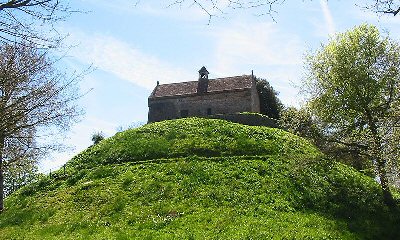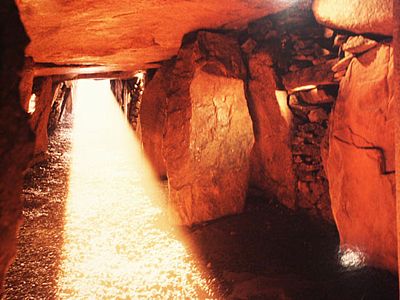|
Location:
Jersey.
(683,504). |
Grid Reference:
49� 12' N, 2� 3.8'
W. |

 La Hougue Bie:
(Passage Mound).
La Hougue Bie:
(Passage Mound).
La Hougue Bie is Jersey's most famous ancient site, and
pilgrims from pre-Christian times onward have journeyed here to worship.
It is t he second
longest cruciform passage-mound in Europe (Only Newgrange has a longer
passage).
The presence of such a
large passage mound on such a small Island is possibly explained by the
fact that Jersey became an island at c. 4,000 BC, at the extremes of
estimates for the building of the mound.
('Hougue'
is a J�rriais/Norman word meaning a "mound" and comes from the Old Norse
word haugr).
The Neolithic inhabitants of the Island, probably
few in number, manhandled over 70 massive stones from miles away and
manoeuvred them carefully into position. They also gathered sufficient
spoil and debris to create a mound standing around 14 metres, then
covered it with soil to make it look like a natural hill.

This
remarkable site
consists of a 20 metre long passage chamber covered by a (currently) 12 metre high
earth mound. The main chamber is cruciform, and was originally paved
with
maroon pebbles. The site was first excavated in 1925 by the Soci�t�
Jersiaise. Fragments of twenty vase supports were found along with the
scattered remains of at least eight individuals.

The ancient
passage-grave divides into three sections. The distance
from the angled entrance to the long passage, giving into the oval Great
Chamber, marks out the first section. The second is the oval-shaped
Great Chamber itself where five immense slabs, the largest weighing 25
tons, form the roof of the chamber. The third section comprises three
side cells, composing a cruciform chamber, the western asp of which is unique, with no counterpart in
any other megalithic structure.
(More about
Cruciform chambers)
The excavators of 1924
noted that the floor of the entire monument was covered with a layer of
"sea gravel" some 2 to 4 inches thick. The floor of the western section
of the chamber had received special treatment, being further raised
creating a stepped 'altar' section. Two of the stones in this section
were determined to be granite, moved from 7 miles distant. They are
presumed to have been specially selected, perhaps in relation to the
astronomical orientation of the passage which would have given the end
chamber a special significance.

The concave design of the entrance is still in its
original shape, something which some other prominent passage mounds
(such as Newgrange), suffered from
under the hands of the 1960's restoration teams.
|
Chronology:
Originally constructed
sometime between 4,000 and 3,500 BC (2), (3). The
mound is now 12 m high but may have been considerably larger in Neolithic
times.
The mound has been
shown to have been built over several phases of construction, ending
sometime around 2,900 - 2,500 BC being symbolically covered over and
sealed with a huge layer of topsoil.
Two medieval chapels
were built in the sixteenth century, thereby Christianising a pagan site.
A well was added
in the 1920's and even a lavatory (removed in excavation). (The concrete
pillar inside dates from then).
The Germans added a
bunker during World War 2.
|
Legend and Tradition:
A manuscript dating from 1734 provides a possible explanation for the
name 'Hougue Bie'. Legend has it that Lord Hambye sailed from Normandy
to slay a dragon that was threatening Jersey, in the process of which he
was murdered by his servant, the latter seeking glory for himself as
slayer of the dragon; his crime revealed, the servant was duly punished.
Lady Hambye ordered that a large mound be built upon high ground as a
memorial to her murdered husband, and the body interred therein. The
mound was named La Hougue Hambye of which Hougue derives from the Old
Norse Haugr meaning eminence or mound, and the Bie may well have become
a shortened form of Hambye over the years.

Astronomy:
Since the excavations and restoration of the original
entrance of the passage observations from inside the tomb at sunrise on
the spring and autumn equinox have revealed that the orientation of the
passage allows the sun's rays to shine through to the chamber entering
the back recess of the terminal cell. (1)

The Neolithic builders on
Jersey built La Hougue Bie to tie-in with the equinoxes which fall twice
a year on days with exactly 12 hours of light and 12 hours of darkness, as
the sun rises a beam of light shines right through to the very back wall of
the raised section of the passage-mound.

(Other Passage Mounds)
(Prehistoric English
Sites)
(Prehistoric French
Sites)
|






